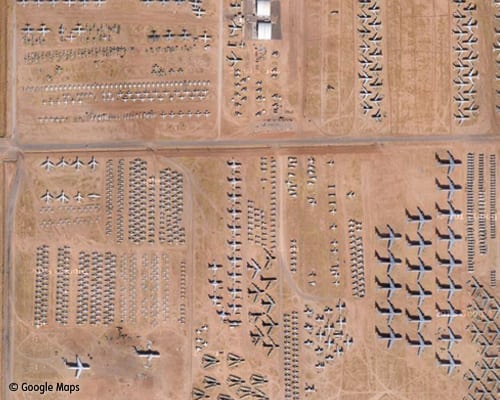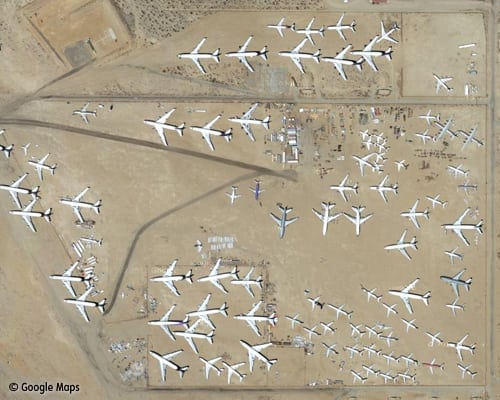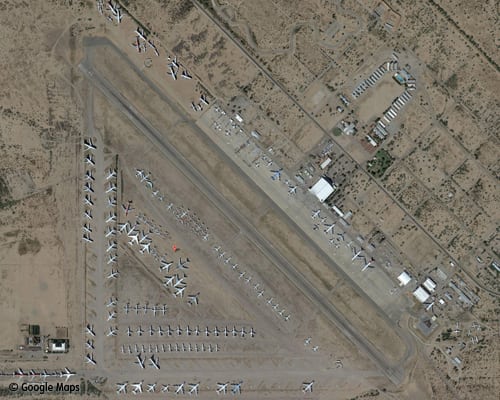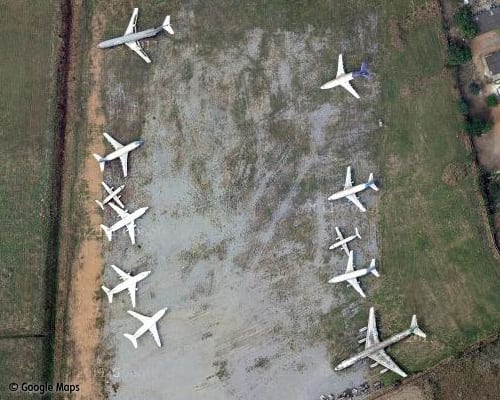Aircraft Graveyards: A Global Halloween Tour of Aviation’s Final Resting Places

From scorching desert sands to humid tropical climates, aircraft graveyards dot the globe, each telling its own haunting tale of aviation history. This Halloween, we’re taking you on a worldwide journey to explore these fascinating facilities where aircraft come to their final rest – or sometimes, await their resurrection.
Each location below can be explored via Google Maps satellite view. Click on our interactive links to virtually wander these massive facilities and appreciate their true scale. Zoom in to spot different aircraft types and storage patterns.
The Giant of Aircraft Storage: Davis-Monthan AFB
Known simply as “The Boneyard,” Davis-Monthan Air Force Base in Tucson, Arizona, reigns as the world’s largest aircraft storage facility. Spanning 2,600 acres of desert terrain, this massive facility hosts over 4,000 aircraft in various states of preservation. The arid climate serves as nature’s preservative, keeping these aluminum giants safe from corrosion as they await their ultimate fate.
Check out this cool video for a tour.
Mojave: Where Space Dreams Rest
The Mojave Air and Space Port tells a different story. Once a hub of aerospace innovation and testing, sections of this legendary facility now house retired commercial aircraft. From massive Boeing 747s to experimental prototypes, these silent sentinels stand watch over the California desert, their stories etched in desert-weathered fuselages.
The Pandemic’s Parking Lot: Southern California Logistics Airport
When the world stopped in 2020, Victorville’s Southern California Logistics Airport became an unexpected sanctuary. Hundreds of grounded aircraft created an unprecedented gathering, their perfectly aligned shadows stretching across the desert floor at sunset. Today, it remains a crucial storage facility for commercial aviation.
Arizona’s Hidden Aviation Cemetery: Pinal Airpark
Tucked away in Marana, Arizona, Pinal Airpark presents an almost post-apocalyptic landscape. This active airport doubles as a storage facility, where dozens of aircraft in various stages of retirement create a haunting tableau against the desert backdrop. Here, some aircraft find new life through parts recycling, while others settle in for their eternal desert rest.
Lagos: Africa’s Aircraft Collection
At Murtala Muhammed International Airport in Lagos, Nigeria, a unique collection of aircraft tells compelling stories of African aviation history. Unlike its desert counterparts, this tropical facility faces distinct preservation challenges, offering a fascinating contrast in how different climates shape aircraft storage strategies. The site stands as a testament to the global nature of aviation’s lifecycle.
Why Aircraft Graveyards Matter
These facilities serve crucial roles beyond their eerie appearance:
- Preservation of valuable parts and materials
- Emergency storage during industry downturns
- Historical conservation
- Environmental protection through proper aircraft disposal
- Military asset management
Explore These Sites Yourself
Each of these locations can be explored via Google Maps satellite view, offering a bird’s-eye perspective of their massive scale. Zoom in to spot different aircraft types, storage patterns, and the sheer magnitude of these facilities. This website has links to many more aircraft boneyards worth exploring.
Did You Know?
- The Boneyard in Tucson is visible from space
- Many stored aircraft return to active service after years in storage
- Different climates require unique preservation techniques
- These facilities have appeared in numerous Hollywood films
- Some aircraft are preserved specifically for museum display
As you celebrate this Halloween, remember that aircraft graveyards represent more than just the end of the line. They’re crucial facilities in aviation’s circle of life, where retired aircraft can find new purpose through parts recycling, preservation for future generations, or sometimes even a complete return to service. From desert to tropics, these fascinating facilities keep aviation’s history alive while serving the needs of modern air transport.









